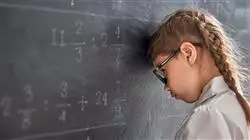University certificate
The world's largest faculty of education”
Introduction to the Program
If you want to improve the academic development of children with difficulties, do not hesitate to specialize with us”

Education is one of the fields in which teachers are active. With their work they can help their patients' academic performance, especially with aspects related to neuropsychology.
The work of neuropsychology in education is complex. It covers a broad spectrum of intervention that requires the professional to have very specific training in the various branches of brain development. This discipline, deeply linked to neurology and the physiological study of the brain, is affected by the changes that the evolution of knowledge in this scientific branch achieves. This means for the professional, an intense challenge of permanent updating that allows them to be at the forefront in terms of approach, intervention and follow-up of the cases that may arise in their consultation.
Throughout this training, the student will go through the aspects related to Difficulties in the Academic Field, such as: visual and auditory functionality for reading, language, languages and learning; motor skills and writing; dyslexia, dyscalculia and hyperactivity problems; or difficulties in neurolinguistic processes, among other aspects. A high-level step that will become a process of improvement, not only on a professional level, but also on a personal level.
We will not only take you through the theoretical knowledge we offer, but we will introduce you to another way of studying and learning, one which is simpler, more organic and more efficient. We will work to keep you motivated and to create in you a passion for learning. And we will push you to think and develop critical thinking.
In-depth knowledge of neurodevelopment and its multiple implications, in a complete Postgraduate diploma created to propel you to another professional level”
This Postgraduate diploma in Difficulties in the Academic Field contains the most complete and updated program on the market. The most important features of the program include:
- The latest technology in e-learning software
- Intensely visual teaching system, supported by graphic and schematic contents that are easy to assimilate and understand
- The development of practical case studies presented by practising experts
- State-of-the-art interactive video systems
- Teaching supported by telepractice
- Continuous updating and recycling systems
- Self-regulated learning: full compatibility with other occupations
- Practical exercises for self-assessment and learning verification
- Support groups and educational synergies: questions to the expert, debate and knowledge forums
- Communication with the teacher and individual reflection work
- Content that is accessible from any fixed or portable device with an Internet connection
- Supplementary documentation databases are permanently available, even after the training
A training created for professionals who aspire to excellence and that will allow you to acquire new skills and strategies in a smooth and effective way"
The teaching staff includes professionals from the field of education, who bring their experience to this training program, as well as renowned specialists from leading societies and prestigious universities.
The multimedia content, developed with the latest educational technology, will provide the professional with situated and contextual learning, i.e., a simulated environment that will provide immersive training programmed to train in real situations.
This program is designed around Problem Based Learning, whereby the teacher must try to solve the different professional practice situations that arise during the academic year. For this purpose, the professional will be assisted by an innovative interactive video system developed by renowned and experienced experts in academic difficulties.
A deep and comprehensive dive into strategies and approaches in Neuropsychology and Education"

The basic processes of cognitive development in relation to learning and school development, in an intensive and comprehensive training"
Syllabus
The contents of this training have been developed by the qualified teachers a clear purpose: to ensure that our students acquire each and every one of the necessary skills to become true experts in this field.
The content of this training enables you to learn all aspects of the different disciplines involved in this field: A complete and well-structured program that will take you to the highest standards of quality and success.

Through a complete and very well-organized program, you will be able to access the most advanced knowledge in Difficulties in the Academic Field"
Module 1. Visual and Auditory Functionality for Reading, Language, Languages and Learning
1.1. Vision: Functioning and Neuropsychological Bases
1.1.1. Introduction
1.1.2. Development of the Visual System at Birth
1.1.3. Risk factors
1.1.4. Development of other Sensory Systems during Infancy
1.1.5. Influence of Vision on the Visuomotor System and its Development
1.1.6. Normal and Binocular Vision
1.1.7. Anatomy of Human Eyes
1.1.8. Eye Functions
1.1.9. Other Functions
1.1.10. Visual Pathways to the Cerebral Cortex
1.1.11. Elements that Favor Visual Perception
1.1.12. Vision Diseases and Alterations
1.1.13. Most Common Eye Disorders or Diseases: Classroom Interventions
1.1.14. Computer Vision Syndrome (CVS)
1.1.15. Attitudinal Observation of the Student
1.1.16. Summary
1.1.17. Bibliographical References
1.2. Visual Perception, Assessment and Intervention Programs
1.2.1. Introduction
1.2.2. Human Development: Development of the Sensory Systems
1.2.3. Sensory Perception
1.2.4. Neurodevelopment
1.2.5. Description of the Perceptual Process
1.2.6. Color Perception
1.2.7. Perception and Visual Skills
1.2.8. Evaluation of Visual Perception
1.2.9. Intervention for the Improvement of Visual Perception
1.2.10. Summary
1.2.11. Bibliographical References
1.3. Tracking Eye Movements
1.3.1. Introduction
1.3.2. Eye Movements
1.3.3. Tracking Eye Movements
1.3.4. Ocular Motility Recording and Assessment
1.3.5. Ocular Motility-Related Disorders
1.3.6. The Visual System and Reading
1.3.7. Development of Skills in Learning to Read
1.3.8. Improvement and Training Programs and Activities
1.3.9. Summary
1.3.10. Bibliographical References
1.4. Saccadic Movements and Their Implication in Reading
1.4.1. Introduction
1.4.2. Models of the Reading Process
1.4.3. Saccadic Movements and Their Relation to Reading
1.4.4. How Saccadic Movements are Assessed
1.4.5. The Reading Process at the Visual Level
1.4.6. Visual Memory in the Reading Process
1.4.7. Investigations to Study the Relationship Between Visual Memory and Reading
1.4.8. Reading Difficulties
1.4.9. Specialized Teachers
1.4.10. Social Educators
1.4.11. Summary
1.4.12. Bibliographical References
1.5. Visual Accommodation and its Relation to Posture in the Classroom
1.5.1. Introduction
1.5.2. Mechanisms that Allow for Accommodation or Focus
1.5.3. How is Visual Accommodation Assessed?
1.5.4. Body Posture in the Classroom
1.5.5. Visual Accommodation Training Programs
1.5.6. Aids for Visually Impaired Students
1.5.7. Summary
1.5.8. Bibliographical References
1.6. Structure and Function of the Ear
1.6.1. Introduction
1.6.2. The World of Sound
1.6.3. Sound and its Propagation
1.6.4. The Auditory Receptors
1.6.5. Ear Structure
1.6.6. Development of the Hearing System at Birth
1.6.7. Development of Sensory Systems during Infancy
1.6.8. Influence of the Ear on Balance Development
1.6.9. Ear Diseases
1.6.10. Summary
1.6.11. Bibliographical References
1.7. Auditory Perception
1.7.1. Introduction
1.7.2. Guidelines for Detecting Auditory Perception Problems
1.7.3. The Perceptive Process
1.7.4. Role of the Auditory Pathways in Perceptual Processes
1.7.5. Children with Impaired Auditory Perception
1.7.6. Evaluation Tests
1.7.7. Summary
1.7.8. Bibliographical References
1.8. Evaluation of Hearing and its Alterations
1.8.1. Introduction
1.8.2. Evaluation of the External Auditory Canal
1.8.3. Otoscopy
1.8.4. Air Audiometry
1.8.5. Bone Conduction Hearing
1.8.6. Curve of the Threshold of Molestia
1.8.7. Tone Audiometry, Vocal Audiometry and Acoustic Audiometry
1.8.8. Hearing Impairment: Degrees and Types of Hearing Loss
1.8.9. Causes of Hearing Loss
1.8.10. Psychobiological Aspects of Hearing Impairment
1.8.11. Summary
1.8.12. Bibliographical References .
1.9. Hearing and Learning Development
1.9.1. Introduction
1.9.2. Development of the Human Ear
1.9.3. Programs, Activities and Games for Auditory Development in Children
1.9.4. Berard Method
1.9.5. Tomatis Method
1.9.6. Visual and Hearing Health
1.9.7. Adaptations of Curricular Elements
1.9.8. Summary
1.9.10. Bibliographical References
1.10. Vision and Hearing Processes Involved in Reading
1.10.1. Introduction
1.10.2. Tracking Eye Movements
1.10.3. The Visual System and Reading
1.10.4. Dyslexia
1.10.5. Color-Based Therapies for Dyslexia
1.10.6. Visual Impairment Aids
1.10.7. Summary
1.10.8. Bibliographical References
1.11. Relationship Between Vision and Hearing in Language
1.11.1. Introduction
1.11.2. Relationship Between Vision and Hearing
1.11.3. Verbal-Auditory and Visual Information Processing
1.11.4. Intervention Programs for Hearing Disorders
1.11.5. Guidelines for Teachers
1.11.6. Summary
1.11.7. Bibliographical References
Module 2. Motor Skills, Laterality and Writing
2.1. Neurodevelopment and Learning
2.1.1. Introduction
2.1.2. Perceptual Development
2.1.3. Neuropsychological Basis of Motor Development
2.1.4. Laterality Development
2.1.5. Interhemispheric Communication through the Corpus Callosum
2.1.6. Ambidextrousness
2.1.7. Summary
2.1.8. Bibliographical References
2.2. Psychomotor Development
2.2.1. Introduction
2.2.2. Gross Psychomotricity
2.2.3. General Dynamic Coordination: Basic Skills
2.2.4. Fine Motor Skills and their Relationship with Writing
2.2.5. Psychomotor Development Evaluation
2.2.6. Summary
2.2.7. Bibliographical References
2.3. Neuropsychology of Motor Development
2.3.1. Introduction
2.3.2. Relationship between Motor and Psychism
2.3.3. Disorders of Motor Development
2.3.4. Coordination Acquisition Disorders
2.3.5. Vestibular System Disorders
2.3.6. Writing
2.3.7. Summary
2.3.8. Bibliographical References
2.4. Introduction to Laterality Development
2.4.1. Introduction
2.4.2. Laterality Tests
2.4.3. Observation Guidelines for Teachers
2.4.4. Crossed Laterality
2.4.5. Types of Cross Laterality
2.4.6. Relationship between Dyslexia and Laterality
2.4.7. Relationship between Laterality and Attention, Memory and Hyperactivity Problems
2.4.8. Summary
2.4.9. Bibliographical References
2.5. Development of Laterality at Different Ages
2.5.1. Introduction
2.5.2. Laterality Definition
2.5.3. Types of Laterality
2.5.4. Corpus Callosum
2.5.5. Cerebral Hemispheres
2.5.6. Development of the Prelateral, Contralateral and Lateral Stages
2.5.7. Summary
2.5.8. Bibliographical References
2.6. Motor Disorders and Related Learning Difficulties
2.6.1. Introduction
2.6.2. Motor Disorders
2.6.3. Learning Difficulties
2.6.4. Summary
2.6.5. Bibliographical References
2.7. Writing Process and Acquisition
2.7.1. Introduction
2.7.2. Reading Difficulties
2.7.3. Comprehension Problems that Students May Develop
2.7.4. Evolutionary Development of Writing
2.7.5. History of Writing
2.7.6. Neuropsychological Basis of Writing
2.7.7. Teaching Written Expression
2.7.8. Methods of Teaching Writing
2.7.9. Writing Workshops
2.7.10. Summary
2.7.11. Bibliographical References
2.8. Dysgraphia
2.8.1. Introduction
2.8.2. Learning Styles
2.8.3. Executive Functions Involved in Learning
2.8.4. Definition of Dysgraphia and Types
2.8.5. Common Indicators of Dysgraphia
2.8.6. Classroom Aids for Students with Dysgraphia
2.8.7. Individual Aids
2.8.8. Summary
2.8.9. Bibliographical References
2.9. Contribution of Laterality to the Development of Reading and Writing
2.9.1. Introduction
2.9.2. Importance of Laterality in the Learning Process
2.9.3. Laterality in the Reading and Writing Processes
2.9.4. Laterality and Learning Difficulties
2.9.5. Summary
2.9.6. Bibliographical References
2.10. Role of the School Psychologist and Guidance Counselors for Prevention, Development and Learning Difficulties
2.10.1. Introduction
2.10.2. The Guidance Department
2.10.3. Intervention Programs
2.10.4. Advances in Neuropsychology in Learning Difficulties
2.10.5. Training the Teaching Staff
2.10.6. Summary
2.10.7. Bibliographical References
2.11. Parent Orientation
2.11.1. How to Inform Parents
2.11.2. Activities to Improve Academic Performance
2.11.3. Activities to Improve Lateral Development
2.11.4. Problem-Solving Strategies
2.11.5. Summary
2.11.6. Bibliographical References
2.12. Psychomotor Assessment and Intervention
2.12.1. Introduction
2.12.2. Psychomotor Development
2.12.3. Psychomotor Assessment
2.12.4. Psychomotor Intervention
2.12.5. Summary
2.12.6. Bibliographical References
Module 3. Dyslexia, Dyscalculia and Hyperactivity
3.1. History of Learning Difficulties
3.1.1. Introduction
3.1.2. Definition of Learning Difficulties
3.1.3. Historical Development
3.1.4. Current Learning Difficulties
3.1.5. Neuropsychology of Learning Difficulties
3.1.6. Causes of Learning Difficulties
3.1.7. Classification of Learning Difficulties
3.1.8. Summary
3.1.9. Bibliographical References
3.2. Conceptualization of Dyslexia
3.2.1. Introduction
3.2.2. Definition
3.2.3. Neuropsychological Bases
3.2.4. Features
3.2.5. Subtypes
3.2.6. Summary
3.2.7. Bibliographical References
3.3. Neuropsychological Assessment of Dyslexia
3.3.1. Introduction
3.3.2. Diagnostic Criteria for Dyslexia
3.3.3. How to Evaluate?
3.3.4. Interview with the Tutor
3.3.5. Reading and Writing
3.3.6. Neuropsychological Assessment
3.3.7. Assessment of Other Related Aspects
3.3.8. Summary
3.3.9. Bibliographical References
3.4. Neuropsychological Intervention of Dyslexia
3.4.1. Introduction
3.4.2. Variables Involved
3.4.2. Neuropsychological Field
3.4.3. Intervention Programs
3.4.4. Summary
3.4.5. Bibliographical References
3.5. Conceptualization of Dyscalculia
3.5.1. Introduction
3.5.2. Definition of Dyscalculia
3.5.3. Features
3.5.4. Neurophysiological Basis
3.5.5. Summary
3.5.6. Bibliographical References
3.6. Neuropsychological Assessment of Dyscalculia
3.6.1. Introduction
3.6.2. Assessment Objectives
3.6.3. How to Evaluate?
3.6.4. Report
3.6.5. Diagnosis
3.7.6. Summary
3.6.7. Bibliographical References
3.7. Neuropsychological Interventions of Dyscalculia
3.7.1. Introduction
3.7.2. Variables Involved in the Treatment
3.7.3. Neuropsychological Rehabilitation
3.7.4. Intervention in Dyscalculia
3.7.5. Summary
3.7.6. Bibliographical References
3.8. Conceptualization of ADHD
3.8.1. Introduction
3.8.2. Definition of ADHD
3.8.3. Neuropsychological Bases
3.8.4. Characteristics of Children with ADHD
3.8.5. Subtypes
3.8.6. Summary
3.8.7. Bibliographical References
3.9. Neuropsychological Assessment of ADHD
3.9.1. Introduction
3.9.2. Assessment Objectives
3.9.3. How to Evaluate?
3.9.4. Report
3.9.5. Diagnosis
3.9.6. Summary
3.9.7. Bibliographical References
3.10. Neuropsychological Interventions of ADHD
3.10.1. Introduction
3.10.2. Neuropsychological Field
3.10.3. Treatment of ADHD
3.10.4. Other Therapies
3.10.5. Intervention Programs
3.10.6. Summary
3.10.7. Bibliographical References
3.11. Comorbidity in Neurodevelopmental Disorders
3.11.1. Introduction
3.11.2. Neurodevelopment Disorders
3.11.3. Dyslexia and Dyscalculia
3.11.4. Dyslexia and ADHD
3.11.5. Dyscalculia and ADHD
3.11.6. Summary
3.11.7. Bibliographical References
3.12. Neurotechnology
3.12.1. Introduction
3.12.2. Applied to Dyslexia
3.12.3. Applied to Dyscalculia
3.12.4. Applied to ADHD
3.12.5. Summary
3.12.6. Bibliographical References
3.13. Guidance for Parents and Teachers
3.13.1. Introduction
3.13.2. Guidance on Dyslexia
3.13.3. Guidance on Dyscalculia
3.13.4. Guidance on ADHD
3.13.5. Summary
3.13.6. Bibliographical References
Module 4. Multiple Intelligences, Creativity, Talent and High Abilities
4.1. Theory of Multiple Intelligences
4.1.1. Introduction
4.1.2. Medical history
4.1.3. Conceptualization
4.1.4. Validation
4.1.5. Premises and Basic Principles of Theories
4.1.6. Neuropsychological and Cognitive Science
4.1.7. Classification of the Theories of Multiple Intelligences
4.1.8. Summary
4.1.9. Bibliographical References
4.2. Types of Multiple Intelligences
4.2.1. Introduction
4.2.2. Types of Intelligence
4.2.3. Summary
4.2.4. Bibliographical References
4.3. Assessment of Multiple Intelligences
4.3.1. Introduction
4.3.2. Medical history
4.3.3. Types of Assessments
4.3.4. Aspects to Consider in the Assessment
4.3.5. Summary
4.3.6. Bibliographical References
4.4. Creativity
4.4.1. Introduction
4.4.2. Concepts and Theories of Creativity
4.4.3. Approaches to the Study of Creativity
4.4.4. Characteristics of Creative Thinking
4.4.5. Types of Creativity
4 4.6. Summary
4.4.7. Bibliographical References
4.5. Neuropsychological Basis of Creativity
4.5.1. Introduction
4.5.2. Medical history
4.5.3. Characteristics of Creative People
4.5.4. Creative Products
4.5.5. Neuropsychological Bases of Creativity
4.5.6. Influence of the Environment and Context on Creativity
4.5.7. Summary
4.5.8. Bibliographical References
4.6. Creativity in the Educational Context
4.6.1. Introduction
4.6.2. Creativity in the Classroom
4.6.3. Stages of the Creative Process
4.6.4. How to Work on Creativity
4.6.5. Connection Between Creativity and Thinking
4.6.6. Modification in the Educational Context
4.6.7. Summary
4.6.8. Bibliographical References
4.7. Methodologies for Developing Creativity
4.7.1. Introduction
4.7.2. Programs for Developing Creativity
4.7.3. Projects for Developing Creativity
4.7.4. Promoting Creativity in the Family Context
4.7.5. Summary
4.7.6. Bibliographical References
4.8. Creativity Assessment and Guidance
4.8.1. Introduction
4.8.2. Considerations on Assessment
4.8.3. Evaluation Tests
4.8.4. Subjective Assessment Tests
4.8.5. Guidance on Assessment
4.8.6. Summary
4.8.7. Bibliographical References
4.9. High Capacities and Talents
4.9.1. Introduction
4.9.2. Relationship Between Giftedness and High Capacities
4.9.3. Connection Between Heredity and Environment
4.9.4. Neuropsychological Foundation
4.9.5. Models of Giftedness
4.9.6. Summary
4.9.7. Bibliographical References
4.10. Identification and Diagnosis of High Capacities
4.10.1. Introduction
4.10.2. Main Characteristics
4.10.3. How to Identify High Abilities
4.10.4. Role the Involved Agents
4.10.5. Assessment Tests and Instruments
4.10.6. Intervention Programs
4.10.7. Summary
4.10.8. Bibliographical References
4.11. Problems and Difficulties
4.11.1. Introduction
4.11.2. Problems and Difficulties in the School Environment
4.11.3. Myths and Beliefs
4.11.4. Dyssynchronies
4.11.5. Differential Diagnosis
4.11.6. Differences Between Genders
4.11.7. Educational Needs
4.11.8. Summary
4.11.9. Bibliographical References
4.12. Connection Between Multiple Intelligences, High Capacities, Talent and Creativity
4.12.1. Introduction
4.12.2. Connection Between Multiple Intelligences and Creativity
4.12.3. Connection Between Multiple Intelligences, High Capacities and Talents
4.12.4. Differences Between Talent and High Capacities
4.12.5. Creativity, High Capacities and Talent
4.12.6. Summary
4.12.7. Bibliographical References
4.13. Guiding and Developing Multiple Intelligences
4.13.1. Introduction
4.13.2. Advising Teachers
4.13.3. Multidimensional Student Development
4.13.4. Curricular Enrichment
4.13.5. Strategies at Different Educational Levels
4.13.6. Summary
4.13.7. Bibliographical References
4.14. Creativity for Problem Solving
4.14.1. Introduction
4.14.2. Models of the Creative Process for Problem Solving
4.14.3. Creative Project Development
4.14.4. Summary
4.14.5. Bibliographical References
4.15. Educational Process and Family Support
4.15.1. Introduction
4.15.2. Guidelines for Teachers
4.15.3. Educational Response in Children
4.15.4. Educational Response in Primary Education
4.15.5. Educational Response in Secondary Education
4.15.6. Coordination with Families
4.15.7. Program Implementation
4.15.8. Summary
4.15.9. Bibliographical References

A complete training that will take you through the knowledge you need to compete among the best"
Postgraduate Diploma in Difficulties in the Academic Field
.
Are you facing challenges in your academic performance and looking to overcome the difficulties you encounter on your way to success? At TECH Global University, we have developed the perfect program for you: the Postgraduate Diploma in Difficulties in the Academic Field. Through our online classes, we will provide you with the necessary tools to overcome obstacles and achieve your academic goals effectively. Our innovative and results-oriented approach will allow you to acquire knowledge and practical skills to face the most common difficulties in the academic environment. You will learn effective study strategies, time management techniques, and concentration methods that will maximize your productivity and academic performance; all of this with the support of our teaching methodologies, which will make this process an unparalleled experience. The advantages of our online classes are innumerable. You will be able to access them from anywhere and at any time, adapting them to your schedule and pace of life. You will no longer have to worry about travel or geographical limits. In addition, you will have the support of experienced professionals who will guide you in your learning process and will answer all your doubts and queries.
Improve your quality of life with the teaching of TECH Global University
.
TECH Global University's Postgraduate Diploma in Difficulties in the Academic Field will provide you with the necessary tools to overcome barriers and challenges in your educational path. Our goal is for you to become a successful student, able to face any obstacle and achieve your academic goals with confidence and determination. Don't let academic difficulties stop you on your path to success - enroll now in TECH Global University's Postgraduate Diploma in Difficulties in the Academic Field and discover your potential to succeed in your studies!







